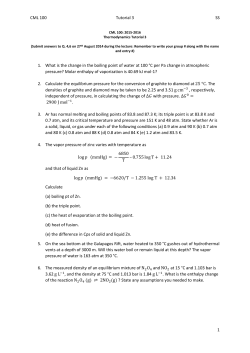
CHM 112 Chapter 11 Worksheet: Intermolecular forces Name
CHM 112 Chapter 11 Worksheet: Intermolecular forces Name ___________________ Q1. If the vapor pressure of Ethylene glycol is 7.23 mm Hg at 95.1˚C and 755 mm Hg at 197.1 ˚C, calculate the heat of vaporization of ethylene glycol. Q2. Graph the following data for vapor pressure of ammonia using excel or another computer program and from the graph determine the heat of vaporization and the normal boiling point for NH3. Temperature in Kelvins 200 210 220 230 235 Q3. Vapor Pressure (Torr) 65.3 134.3 255.7 456.0 597.0 The heat of vaporization of water is 40.7 kJ/mol. What is the vapor pressure of water at 351 K? Q4. Draw the Lewis Structure for each molecule. Identify the type of intermolecular forces in each species. Circle the member of the pair with the corresponding property. (A) Highest boiling point: CCl4 or CBr4 (B) Highest vapor pressure: CH3OH or (C) Lowest Viscosity: (CH 3 ) 2 NH or (CH3)3N (D) Largest ΔH v a p : LiCl or HF CH3Cl Q5. How much heat would be released during the condensation of 5.00 g of Acetone (C3H6O). The molar heat of vaporization for acetone is 30.3 kJ/mol. Q6. How much heat is released when 10.0 g of Steam (water vapor) at 100.0 ˚C is cooled to 37.0 ˚C and the amount of heat released when 10.0 g of water at 100.0 ˚C is cooled to 37˚C? Does this justify the fact the steam causes more severe burns than water even though they are at the same temperature? Q7. List the following molecules in order if increasing boiling points a) KBr, CH3CH2CH2CH2CH3, CH2CH2OH b) CH3CH2NH2, CH3CH2-O-CH2CH3, HOCH2CH2CH2CH2OH Q8. The following molecules have the same molecular formula (C3H8O), yet they have different normal boiling points, as shown. Explain the difference in the boiling points Q9. CO2 forms a solid that sublimes at -78˚C at atmospheric pressure but NO2 forms a liquid that boils at 21˚C at atmospheric pressure. How does this information support that statement that CO2 is linear molecule but NO2 is a nonlinear molecule? Q10. Look at the phase diagram of water below. What phase changes occur in each of the following cases? a) Water at -20.0 ˚C and 21.5 torr is heated to 50 ˚C at a constant pressure b) Water at 0 ˚C originally is compressed from a pressure of 2.15 torr to 800 torr at 0 ˚C ? Q11. Indicate the type of crystal (molecular, metallic, ionic, or covalent-network) would each of the following compounds form on solidification. Would each have a high or low melting point? a) CaCO3 Q12. b) Pt c) ZrO2 d) Kr e) benzene Which of the following molecules will have the higher viscosity and why? f) I2 Q13. What intermolecular forces are responsible for the following differences? a) Xe is a liquid at atmospheric pressure and 120 K while Ar is a gas under the same conditions. b) CH3OH boils at 65 °C while CH3SH boils at 6 °C. c) H2O has a much higher boiling point than H2S d) CO2 is a gas at atmospheric pressure and room temperature while CS2 is a liquid. Q14. Give an example of each kind of solid and state how the solid is bonded and the consequential relative melting point . Molecular Ionic Atomic (noble gas) Atomic (Metallic) Network Covalent Example Bonding? Relative Melting Point Q15. Sketch the phase diagram for oxygen using the following data: Triple point, 54.3 K and 1.14 torr; critical point, 154.6 K and 37828 torr; normal melting point, -218.4 °C; and normal boiling point, -182.9 °C. Does oxygen melt under an applied Pressure (like water does)?
© Copyright 2025





















